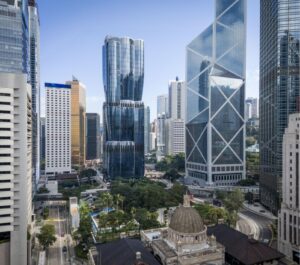MVRDV completes Pixel
Pixel is the first project completed in Makers District, a new development on Abu Dhabi’s Reem Island that developer IMKAN bills as the new heart of Abu Dhabi – a creative counterpart to the city’s cultural hub on the nearby Saadiyat Island.
The design capitalises on the innovative, cosmopolitan spirit of Makers District to offer an approach to living that is rare in the United Arab Emirates – with an emphasis on identity and a strong sense of place, an outdoor lifestyle, community spirit, and modest yet striking materials.
The development forms a central hub in Maker’s District, so the design’s seven compact towers are pushed to the edge of the site, their positions and heights optimised to provide shade, encourage cooling breezes, and create connections with both the waterfront developments that surround the site on three sides and the beach.
Between the towers, a central plaza forms Pixel’s social centre, with restaurants, cafés, and shops soon to occupy the ground floor. Community functions – from a gym and medical clinic to an early learning centre and offices for innovative start-ups – will occupy the level above, ensuring that the buildings of Pixel are always active, and that the plaza is therefore lively throughout the day.
The façades facing this plaza are what truly bring the project to life: At their bases, the towers crumble into “pixels”, spilling out into the plaza to create terraces and bay windows. These extend the living spaces inside into the public realm, encouraging residents to enjoy the outdoors in the cooler months of the year.
Water and green features in the plaza below help to cool the microclimate within the plaza, making for a more comfortable environment outdoors, with planned green roofs being added to the top of the pixels.
Life in the apartments above blends with the life in the plaza, giving a sense of place to the project, and an identity which helps it stand out from other complexes in the Emirates. This identity is further reinforced by the materials used on the project that, despite a certain modesty, nonetheless grab the attention of passers-by.
In a nod to Abu Dhabi’s heritage, the development is envisaged as an oyster, with a hard outer shell that sequesters a delicate pearl inside. The outer façades are made of concrete panels, imprinted with a graphic pattern designed by artist Nicole Martens that was inspired by oyster shells. Glimpsed between the towers, the shading screens of the central plaza, clad in tiles of 14 different pastel colours.
This identity is further reinforced by the materials used on the project that, despite a certain modesty, nonetheless grab the attention of passers-by. In a nod to Abu Dhabi’s heritage, the development is envisaged as an oyster, with a hard outer shell that sequesters a delicate pearl inside.
The outer façades are made of concrete panels, imprinted with a graphic pattern designed by artist Nicole Martens that was inspired by oyster shells. Glimpsed between the towers, the shading screens of the central plaza, clad in tiles of 14 different pastel colours, give the impression of a pearl inside the shell.
On the interior, this modest yet joyful approach to materials continues, with each tower adopting a colour profile that gives it a unique identity and helps to improve wayfinding from the car park below ground. ixel contains 525 apartments of varying sizes, ranging from studios to spacious three-bedroom homes. These apartments are arranged in a way that celebrates diversity, mixing more expensive units and more affordable spaces together.
This is enabled by the pedestrian plaza which, with its vibrant atmosphere, offers a benefit to living on the lower levels and makes these apartments just as desirable as those nearer to the tops of the towers. As a result, the project encourages contact between people from different walks of life – expats and Abu Dhabi locals, large families and singles living alone, the young and the old. Source by MVRDV.
Location: Abu Dhabi, United Arab Emirates
Architect: MVRDV
Founding Partner in charge: Jacob van Rijs
Director: Stefan de Koning
Design Team: Edina Peli, Mariya Gyaurova, Mirco Facchinelli, Kristin Schaefer, Katarzyna Plonka, Ole Allin Egebaek, Ronald Hoogeveen, Katarzyna Nowak, Akshey Krishna Venkatesh, Kevin Loftus, Luca Vacchini, Karin Houwen, Guido Boeters, Meng Yang, Diana Sacco, Stavros Gargaretas, Afrodite Moustroufi
Visualization: Antonio Luca Coco, Paolo Mossa Idra, Costanza Cuccato, Davide Calabro, Pavlos Ventouris, Kirill Emelianov, Tomaso Maschietti, Massimiliano Marzoli, Giovanni Coni
Strategy & Development: Willeke Vester
Architect of Record: Dewan Architects + Engineers with Intercon (interior design)
Engineering and Project Management: Ramboll Middle East
District Masterplan: RNL
Infrastructure: Parsons
Cost Control: Turner & Townsend
Landscape and public realm design: Bjarke Ingels Group
Landscape architect: Verdaus
Lighting: Delta Lighting Design
Wayfinding & Signage: Dezigntechnic
Vertical transportation: Cooper Wilcock
Security: WSP, Consquare
Artist (façade): Nicole Martens
Client: IMKAN
Size and Programme: 85,000 m2 mixed-use
Year: 2024
Photographs: Jon Wallis, Courtesy of MVRDV





